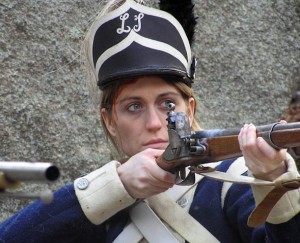True Tales: Character of Deception
By George T. ComeauThe following is an excerpt from “A Character of Deception,” the latest installment of True Tales by Canton historian George Comeau.
What makes for great television is great storytelling. And currently running on our local access channel is a terrific story that brings to life the passionate and unrelenting personality of Deborah Samson. And although Sharon, Massachusetts, can lay claim to her as the first daughter of the American Revolution, Canton plays a more than supportive role in the story.

Courtney Coan of Easton portrays Robert Shurtlieff in the documentary highlighting the life of Deborah Samson. (Courtesy of Steve Connolly)
The character is described as a “lively, comely, young nymph.” An “extraordinary insistence of virtue in a female soldier.” A “display of activity, alertness, chastity, and valour.” The accolades flow: “Being a remarkable heroine, and warmly attached to the cause of her country … she gained a reputation which will be noticed by the compilers of our grand revolution.” This account, written in 1784, sets the tone of our protagonist perfectly.
In case you do not know the plot, Deborah Samson was born on December 17, 1760. A direct descendant of Mayflower passengers, Bradford, Standish, Alden and Mullins, it would seem that Samson’s early life was the driving force behind this remarkable woman. Raised in a broken home as the result of a deadbeat dad, along with her eight siblings, Samson is scattered to the wind. Between 1765 and 1781, this child was pretty much in the foster-care system of the day. Ending up in Middleboro as an indentured servant, Samson wound up teaching school for two years and joining the local Baptist church.
By 1782, when things were heating up in the War against England, Samson attempted to enlist in the Continental Army under the pseudonym Timothy Thayer. Upon discovery, she was barred from service, and so too she withdrew from the church. Soon thereafter, Samson tried to enlist a second time — this time successfully, owing to the fact that she signed up in Bellingham, where presumably she was not known to the local enlistment officers. It also helped that she claimed to be from Uxbridge and was filling a quota for soldiers from that community.
The scene at enlistment is described in Hollywood detail: “Muster Master Noah Taft looked up from his table into the cold blue eyes of a tall rangy blond young man with a firm jutting jaw and a prominent nose, who identified himself as Robert Shurtlieff and stated he wanted to join the army for the balance of the war. Taft paid the youth sixty pounds bounty money, after first deducting his fee, and as Shurtlieff signed, Taft may have noticed that he was left-handed and unable to bend the index finger of his left hand due to an old injury.” The signature was bold, legible and still exists in Massachusetts’ Colonial records.
Samson had successfully become Shurtlieff. Such begins the historical journey of this woman and a winning role in the American Revolution. If a camera crew had covered the event, the action started fast and furious. A three-day march to West Point within 12 days of enlisting as Shurtlieff, followed by encounters with Tories. And although the last major battle of the war had been fought the previous October, guerilla warfare was still being waged across New York and even further south.
One of the Tory units was a vicious group led by Colonel James DeLancy, and several bloody hand-to-hand struggles took place. “In these wild skirmishes Shurtlieff demonstrated his courage, strength, loyalty and fighting skill over and over again. Once when his group was ambushed near Tarrytown, Shurtlieff suffered a forehead wound from a sabre slash and then was felled by two musket balls in the upper left front thigh” — one of the balls torn deep into his thigh, the other he would dig out himself with a knife to avoid being detected as a female.
Shurtlieff is eventually “outed” when serving to suppress a mutiny in Philadelphia, he comes down with Malignant Fever and the attending physician discovers that there are some parts missing from this heroic soldier’s manhood. On October 23, 1783, Shurtlieff is honorably discharged from the Continental Army, and nothing is said of the gender-bending soldier …
The story of Deborah Samson is the subject of a new eight-part documentary by Sharon resident Steve Connolly. See this week’s Canton Citizen to read more about the project and the amazing woman who inspired it. Check local cable listings to watch Deborah Samson & Paul Revere.
Short URL: https://www.thecantoncitizen.com/?p=23315










